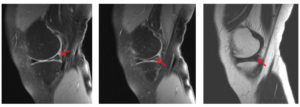Meniscus Surgery Overview
Dr. Millett will recommend surgical repair for a meniscal tear if symptoms are chronic and/or disabling. If the meniscus tear is causing the joint to lock up, then surgery will almost always be needed. In addition, if the tear occurs in the middle or inner region of the meniscus, surgery will also usually be recommended. If meniscus surgery is needed, the procedure will be chosen based on the location of the meniscus tear and it will be performed arthroscopically. The torn portion of the meniscus will typically be repaired using sutures or an absorbable fixation device. These devices join the torn edges of the meniscus so they can heal. Surgery can also take place by:
- Trephination/ Abrasion Technique: This procedure is used for small meniscal tears that are located on the outer area near the meniscus. This area represents a good blood supply and will enhance the healing process quickly. Multiple holes or shavings are made in the torn part of the meniscus to promote the bleeding so that the healing process can begin.
- Partial Resection: A partial resection will occur for tears located in the inner 2/3 of the meniscus where there is not a blood supply. The goal is to stabilize the edge of the meniscus by removing only the torn part of the meniscus. If only the inner portion of the meniscus is removed and the meniscus remains mostly intact, the patient usually heals very well and does not develop early arthritis.
- Complete Resection: This procedure involves the complete removal of the damaged meniscus. This technique is only performed if absolutely necessary.
After Meniscus Surgery
Arthroscopic meniscus surgery is often performed on an out-patient basis. Here are some things to remember about what to expect, as well as some helpful hints during the recovery process immediately following the procedure:
- After meniscus surgery, it is normal to have swelling and discomfort in the knee for several days. Apply ice bags or use the ice machine you were given to control swelling. Ice should be applied 20-30 minutes at a time, every hour or so. Be sure to protect your skin with a thin cloth. Icing is most important in the first 72 hours, although many people find that continuing it lessens their post-operative pain.
- If you had a nerve block during arthroscopic knee surgery, the local anesthetic may keep your leg numb for several hours. You will be given a prescription for pain medication when you are discharged from the hospital. If you find you do not tolerate it well, call our office and we will try another one.
- Keep the leg elevated. This will prevent swelling and help decrease pain. The leg must be elevated higher than the level of your heart.
- Avoid moving the knee after surgery until you begin physical therapy rehab. Despite limiting the motion in your knee, it’s still important to keep blood circulating in your leg. Pumping your ankles up and down and squeezing your quadricep muscles several times every hour is recommended to help prevent blood clots from forming.
- Keep the post-op dressing clean and dry. Unless it becomes wet or too tight because of swelling, leave the bandages in place for at least 2 days, then remove them. Cover the small incisions with waterproof bandages to keep them dry. You may shower, but keep the incisions dry for the first 10-14 days. Do not wet your incisions directly or by submerging (bathing or swimming) until at least 2 weeks post-op.
- The sutures are absorbable and do not need to be removed.
- Dr. Millett would like to see you back in the office 10-14 days after surgery. If you don’t have your first post-op visit scheduled, call our office (970-479-5871) to make one.
- Start your arthroscopic knee surgery post-operative rehabilitation/physical therapy right away. Your physical therapy program is key to a successful outcome. It should be started the day after surgery. A separate prescription will outline the protocol. It often helps to call before surgery to make an appointment with your physical therapist.
- Be in the care of a responsible adult.
- Abstain from drinking alcoholic beverages and from smoking as these behaviors can impact recovery and delay healing.
- You may eat a regular diet, if not nauseated. Drink plenty of non-alcoholic, non-caffeinated fluids.
Rehabilitation after meniscus surgery can be a lengthy process involving a limitation of activities, physical therapy and rest that will need to take place for a period of months. Specific rehabilitation will vary according to each patient’s needs and you must adhere to your own protocol as established by Dr. Millett and your physical therapist.



